As a woman with PCOS, I struggle with balanced inflammation regulation throughout my body. My hands and feet are always tight and swollen in the morning, I’m constantly bloated, and during my menstrual cycle everything including my face is puffy!

This is all pretty average for hormone imbalance, thankfully, God created lots of remedies and practices that help break up and move that fluid and inflammation around! More practices here.
Before I dive in, please be aware; I am not a trained botanist, holistic practitioner (one day), or naturalistic scientist, I have only my own herbalist research and experience
A Short Background on Tea:
Tea has origins from all over the world; India, European countries, even Native American practices.. studies show the earliest verbal record of medicinal tea dates back to 2737 BC in China!.
According to legend, the Chinese emperor Shennong was resting beneath a Camellia Sinensis tree when several dried leaves from the tree landed in his water jar, discoloring the water. Shennong, being a curious fellow, decided to try the infusion. He was pleased to discover that the tea not only had a delightful flavor, but also possessed restorative properties!
Yaupon was used by Native Americans for traditional medicine, sacred ceremonies, friendship rituals and as a stimulating tea-like beverage. It was referred to as the Beloved Tree, Big Medicine, The Purifier and the Black Drink. Yaupon tea contains antioxidants comparable to other super foods like green tea and blueberries.
Some of the more popular and widely known teas are:
- Peppermint
- Green tea
- White tea
- Black tea
- Chamomile
- Hibiscus
- Chai
just to name a few.
What is Inflammation?
Inflammation is part of the body’s defense mechanism, the inflammatory response is a complex process that involves the immune system, cells, and blood vessels. It’s a natural process that is essential for healing and protection from infection. Although natural, copious amounts can become a problem and cause tissue damage. Too much inflammation is linked to obesity, heart disease, brain disease, diabetes, hormone imbalance, immune system diseases, and cancer. Lets look at teas that can lower these risks and help support healthy regulation of inflammatory responses!

Anti-Inflammatory Herbs and Teas:
- Dandelion Root Tea – Can detox the liver and kidneys being a natural diuretic, is rich in vitamin K, which is important for bone health, and is packed with antioxidants!
- Rosehip Tea – The fruit of the rose plant, rose hips are high in vitamin C and may have anti-inflammatory and antioxidant properties. They can be used whole in tea or powdered and used as a seasoning. Some evidence suggests that rose hips may help with arthritis pain!
- Raspberry Leaf Tea – This plant has a tannic flavor like black tea. It’s high in vitamin C, potassium, magnesium, and B vitamins. Raspberry leaf tea is rich in nutrients like iron, calcium, and magnesium, which are important for fertility and reproductive health
- Ginger Tea – Highly anti-inflammatory and packed with vitamins and minerals needed to support a healthy viral and immune system. Ginger root is also very effective for nausea and digestion issues!
- Butterfly Pea Tea – Due to its anti-inflammatory properties, it can help reduce the irritation of the lungs and drain an excessive fluid build-up. Butterfly pea tea also has therapeutic properties that can help treat asthma and various respiratory allergies.
- Lemon Balm – A perennial herb from the mint family that has been used in traditional medicine for its anti-inflammatory properties and anxiety-calming affects.
- Tumeric – Traditionally used in the Orient for both prevention and therapy of diseases. Modern studies show that turmeric has anti-inflammatory properties, as well as antioxidant, antimutagenic, antimicrobial, and anticancer properties.
These teas are staples on any naturopathic’s shelf! They provide a wide range of medicinal benefit and are easy to grow in your own herb garden!
Lets do a deeper dive into the benefits of each tea listed above:
Dandelion Root Tea
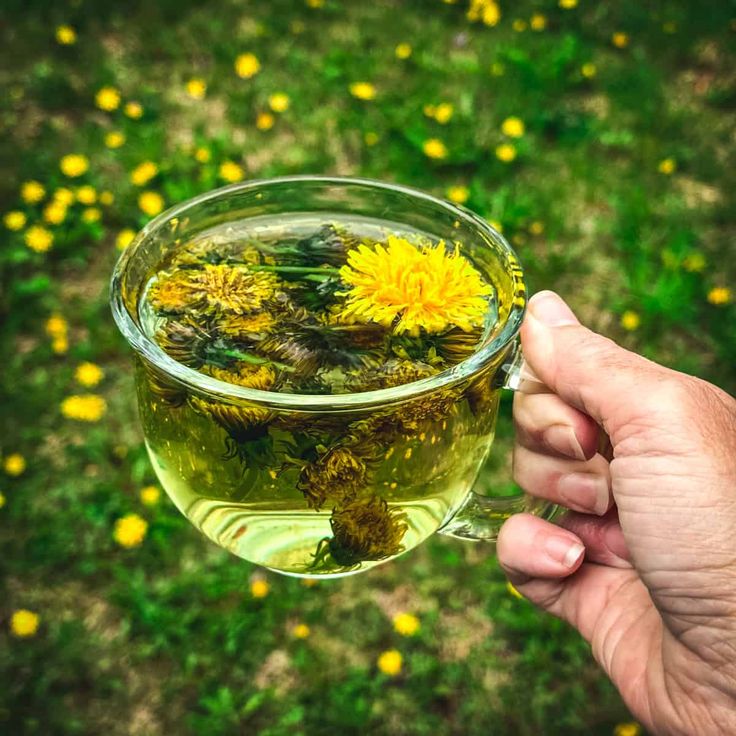
Dandelion Root is a powerful detoxifier and its chalked full of vitamins like B, E, and K. Minerals like calcium, iron, magnesium and zinc make the root a powerful cancer fighter as well as a diuretic and can help balance healthy blood sugar levels.
Phytochemicals and anti-oxidents like polyphenol and beta-carotene allow this plant to lower oxidative stress levels and help prevent age-related diseases like diabetes, dementia, and osteoporosis
Dandelion is rich in vitamin C, which helps protect cells from damage caused by toxins. Dandelion root can also inhibit the activity of lipase, an enzyme that helps the body absorb fat from food, making a hot cup of tea on an empty stomach excellent for weight loss!
One of the best parts about this powerful plant is that it grows everywhere! From Spring through Autumn the best nutritional harvest depends on the time of year.
In Spring before new growth, the root serves the least bitter taste. This is also when nutrients are at their peak. In late Fall when the plant is storing energy in its roots there’s a more robust flavor. The amount of inulin in dandelion roots varies by season, with the smallest amount in spring and the largest in autumn. Inulin has several beneficial effects, including eliminating pathogens in the gastrointestinal tract, and repressing obesity, cancer, and osteoporosis.
Steeping the root either whole or ground, in hot water for 3 to 5 minutes (longer for deeper taste) and adding a tsp of honey creates a delicious and earthy way to relax and help your body fight!
Dandelion is generally considered safe for most people, but some people may have an allergic reaction to it. Dandelion can also interact with certain medications, so you should consult your doctor before drinking dandelion tea if you take prescription medications.
Rosehip Tea

Rosehip tea is loaded with vitamins C, E, A, and B, plus antioxidants and other minerals. Rosehips are especially rich in vitamin C, which is essential for immune function and other bodily processes. Unfortunately, some of the vitamin C is lost during the brewing process. An 8-ounce cup of unfortified rosehip tea has about 7.5 milligrams of vitamin C. For adults, the recommended daily amount is 75–120 milligrams. So, if you want to get the full benefits of rosehip tea, you may want to drink several cups per day.
Because this delicate bud is full of antioxidants, rosehip can be extremely ant-inflammatory and can help manage pain and stiffness in people with osteoarthritis. Also, due to the high amounts of vitamin C, its an easy way to fight against cold and flu season, which is on the way! Here’s a few more benefits Rosehip tea provides:
- Digestion aid
- Weight loss support
- Clear skin
- Healthy hair
Rosehip comes into season after the first frost in Autumn, so we’re pretty close to ripe, ready to steep tea! The drink can be enjoyed hot or iced, I personally like to make an Iced Rosehip and Mint Refresher for an energizing morning treat!
The best way to prepare rose hips for tea is by cutting the fruit in half, laying them out on a paper towel and allowing them to dry out for a couple days. Once wrinkled and dry like a raisin, you simply add the dried fruit to hot water and steep! I recommend steeping longer than you would ordinary tea leaves for a more intense flavor!
————————————————————————————————————————–
Raspberry Leaf Tea
This is one of my favorite teas as it is literally a God given medicine straight from the Earth! Raspberry Leaf is an amazing herb used for centuries in woman’s reproductive health including : regulating cycles, supporting healthy hormone balance, easing pain and strengthening the muscles for birth, and post par-tum and pre/post menopause! When it comes to a woman’s health, raspberry leaf tea is the drink to have on hand.

This leaf carries many anti-oxidants and minerals like vitamin C, E, A, B, calcium, iron, potassium and magnesium. Some studies show red raspberry leaf tea increases blood flow to the uterus, helping to tone and strengthen the muscle fibers for a less painful menstruation, a smoother labor and delivery, and easier transition into menopause.
Drinking the tea throughout your full cycle can help support healthy fertility during ovulation as well as balance hormones as you heal from the Follicular Phase. Red raspberry leaves contain vitamin B6, which binds to estrogen, progesterone, and testosterone to help regulate these hormones. Vitamin B6 can also help with mood swings related to hormones!
Because the components of this herb can act like estrogen, it is not safe to drink during the first 32 weeks of your pregnancy. After your 32nd week it is safe to consume a cup to two cups a day, make sure to drink plenty of water as this tea can act as a mild diuretic. At this point in your pregnancy the tea will target the uterus, strengthening the muscle and preparing for a shorter, easier labor, the studies and testimonies of red raspberry leaf and its benefits for women really prove how amazing the little leaves are and is a testimony itself to our great Creator and His plan for us!
———————————————————————————————————————————-
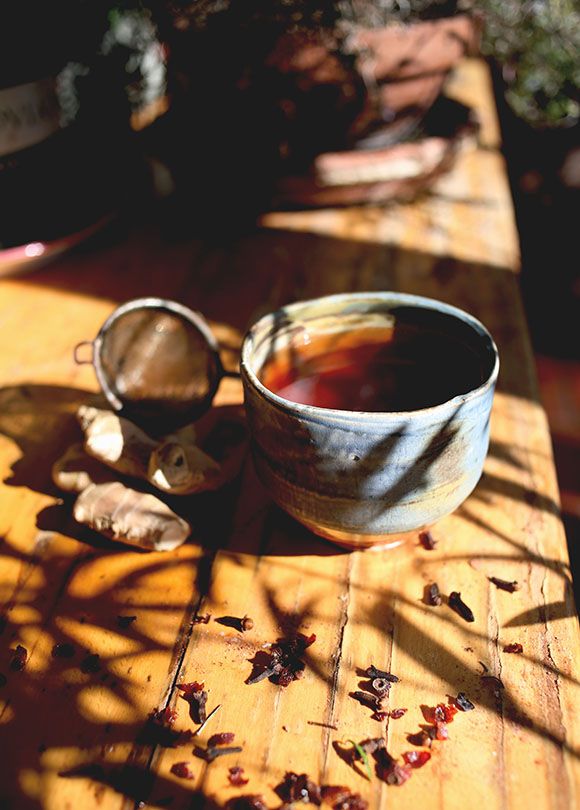
Ginger Tea
Ginger Tea is an ancient herbal remedy that comes from the Zingiberaceae family of plants in Asia. The root is chopped and dried, or peeled and boiled depending on the depth of taste you acquire.
Ginger brings a strong fight against flu and cold season, as it is full of vitamin C, vitamin B6, magnesium, potassium, copper, manganese, fiber and water. Ginger’s anticholinenergic and antiserotonergic actions increase gastric tone and motility, which can help relieve nausea and increase digestibility and speed up gastric emptying, which can help reduce nausea while aiding digestion. This makes it a great choice for morning sickness during pregnancy!
Ginger root is also very effective against a sore throat and other cold and allergy related pains. Because ginger is naturally antibacterial, drinking the tea can help kill out infection and stimulate new healthy cell growth by aiding the immune system. It’s quite literally a healing tonic! There are also lots of ways to enjoy the healing properties of ginger, check out how to make Ginger Lozenges here!
To that extent, remember too much of anything can harm you, a cup to two cups a day is a good balance for ginger tea. Speak with your doctor before using if you have diabetes, have heart conditions, take blood thinners or have any bleeding disorders as ginger tea can lower blood sugar levels and thin the blood. BE safe and always do your research!
————————————————————————————————————————————————————————
Butterfly Pea
One of the prettiest teas I’ve ever seen, Butterfly Pea is a lovely purpley-blue flower that tastes just like a sugar snap pea! Kind of strange at first, but the benefits are worth trying!
To start, butterfly pea extract is very useful in Skin and Hair care, thanks to a high concentration of naturally occurring polyphenols (Proanthocyanidin or condensed Tannis), and flavonoids, a potent antioxidant. Specifically, proanthocyanidin, which stimulates the natural production of collagen and elastin.
The anthocyanin content of this tea helps to fight cancer and the risk of diabetes, Butterfly pea tea is rich in antioxidants, including anthocyanins, kaempferol, quercetin, myricetin glycosides, gallic acid, and p-coumaric acid. This tea is also rich in vitamins A, C, E, and other compounds, such as lactones, phytosterols, terpenoids, dietary fiber, fatty acids, and cyclotides.

Lots of big words but together these components make up a powerful virus fighting and immune strengthening brew that supports the body’s cell reproduction and vitality!
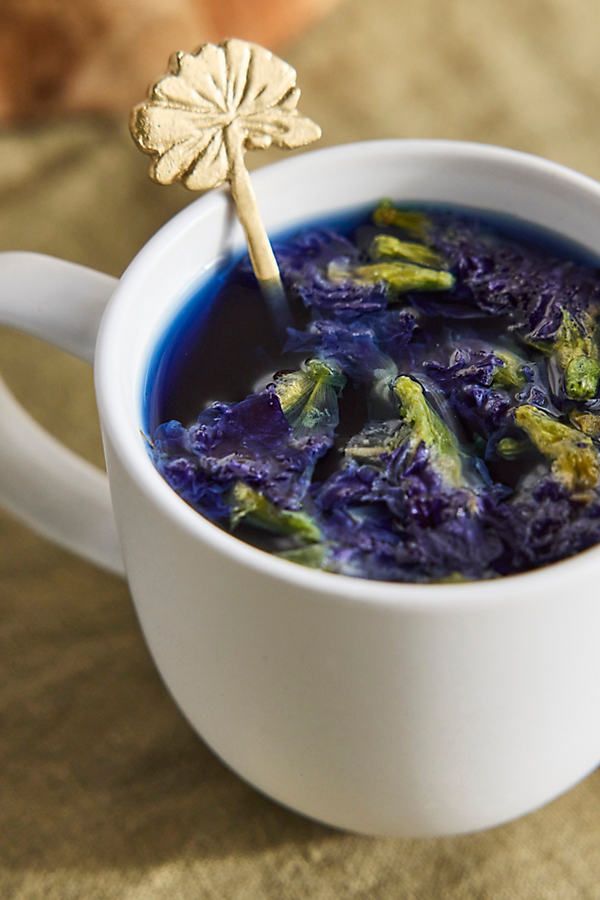
Research also suggests that butterfly pea tea may help support healthy digestion and gut health, which is highly linked to immune function, and protect the gastrointestinal tract from spasms, nausea, heartburn and ulcers.
The surprises don’t stop with this violet colored flower, butterfly pea tea is naturally blue at a neutral pH level. When the pH level is lowered, the tea turns purple and then red, so add a squeeze or two of lemon and watch the colors change! It’s so magical, and perfect for Halloween!
—————————————————————————————————————————————————
Lemon Balm Tea
Lemon Balm is native to Southern Europe, its use has been widely accustomed in many herbal practices across the globe.
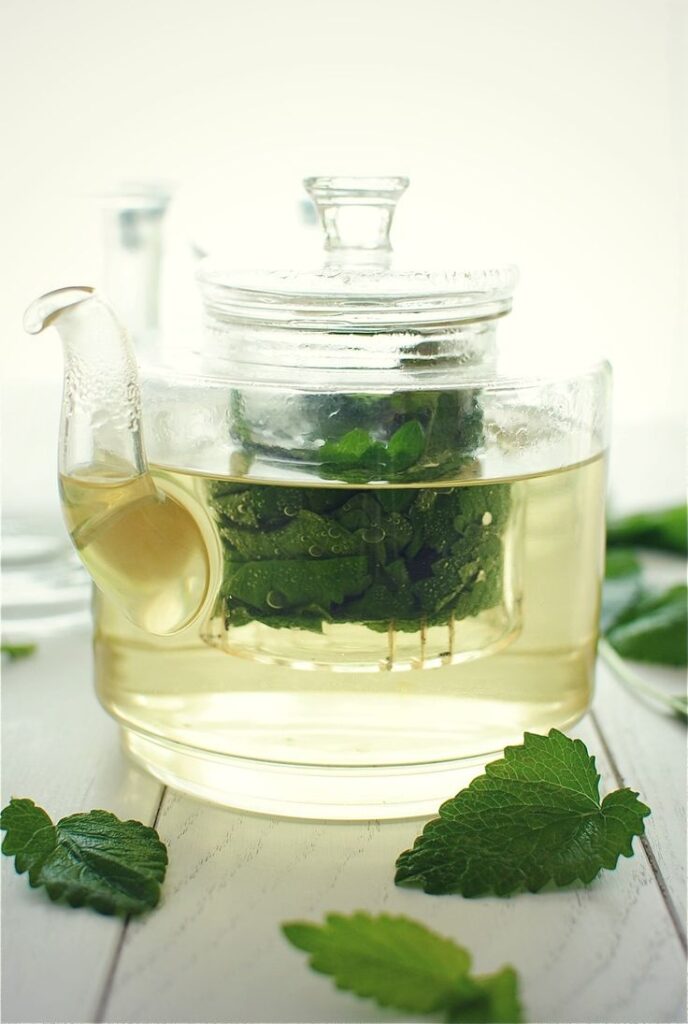
Lemon balm contains vitamins and minerals, including: vitamin C, thiamin, a B vitamin, potassium, sodium, magnesium, calcium, and iron. Lemon balm also contains eugenol, a natural compound that has antibacterial and anti-inflammatory effects. Eugenol is also found in cloves.
Other compounds this herb contains are:
Phenolic compounds like rosmarinic acid, caffeic acid, cholinergic acid, and metrilic acid. Flavonoids, including luteolin and apigenin. Terpenes, which are plant chemicals that may contribute to the herb’s relaxing effects. Tannins, which may be responsible for many of the herb’s antiviral effects.
Studies also show that lemon balm ointments can help heal cold sores caused by the herpes simplex virus (HSV). Lemon balm extract has been shown to have high virucidal activity, which means it can destroy viruses.

These vitamins and minerals work together to create a potent antiviral, anti-inflammatory, anxiety reducing, sleep supporting, and digestion aiding tea!
————————————————————————————————————————————————————————
Tumeric
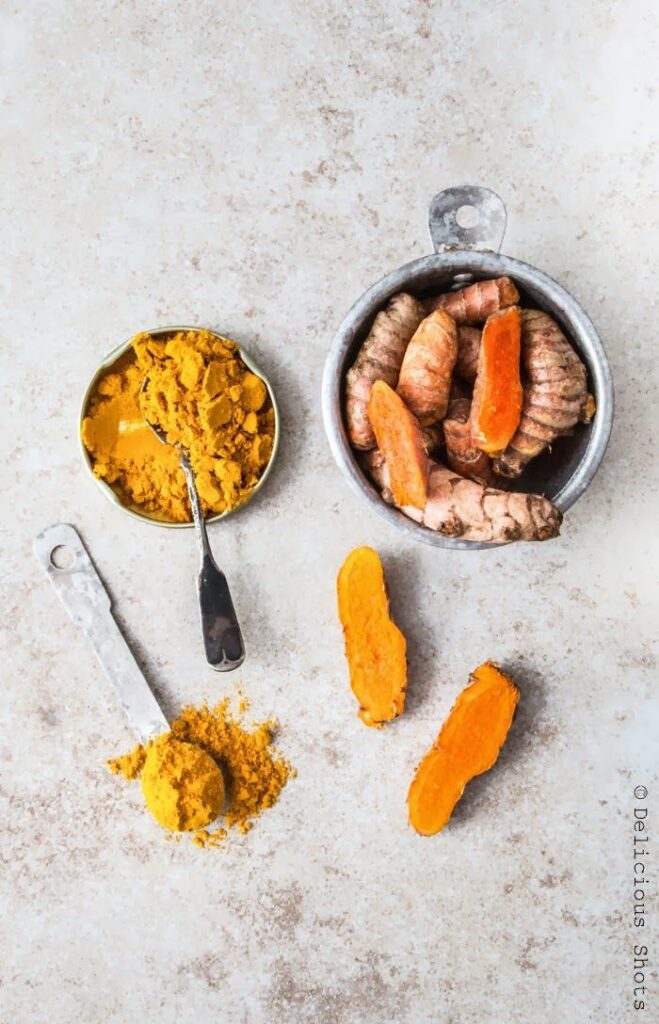
Last but not least, Tumeric. Now you can use tumeric in many ways including powdered, capsuled, whole or peeled, steeped in oil or water, etc. Check out my Tumeric Tea recipe to create a delicious, earthy, medicinal and cleansing drink with this fascinating root!
Originating from South Asia, this golden root has been used for it’s medicinal properties for thousands of years! Turmeric was used as a culinary spice and in religious ceremonies by the Vedic culture in India. It was likely introduced to China by 700 AD, East Africa by 800 AD, West Africa by 1200 AD, and Jamaica in the 18th century.
Tumeric is a juicy root that holds amazing medicinal properties and is a powerhouse of vitamins and nutrients:
- Vitamin C
- Vitamin B6
- Iron
- Potassium
- Manganese
- Calcium
- Phosphorus
- Magnesium
- Copper
- Zinc
The medicinal plant is also chalked full of phytonutrients like curcumin, demethoxycurcumin, and bisdemethoxycurcumin, which are responsible for turmeric’s yellow color.
Tumeric is also full of anti-oxidants! These compounds can neutralize free radicals from pollution and sunlight, which may help protect cells from damage. They can also inhibit the production of enzymes that generate reactive oxygen species (ROS), which are linked to inflammatory disorders and some types of cancer.
Speaking of inflammatory disorders, tumeric is extremely anti-inflammatory. Studies show a daily intake can reduce pain, stiffness, morning swelling and daily swelling in the joints and body due to arthritis and rheumatoid arthritis. Tumeric can also help manage inflammatory bowel diseases and small studies have shown a daily high dose may reduce symptoms of fatty liver disease and help with scarring on the liver!
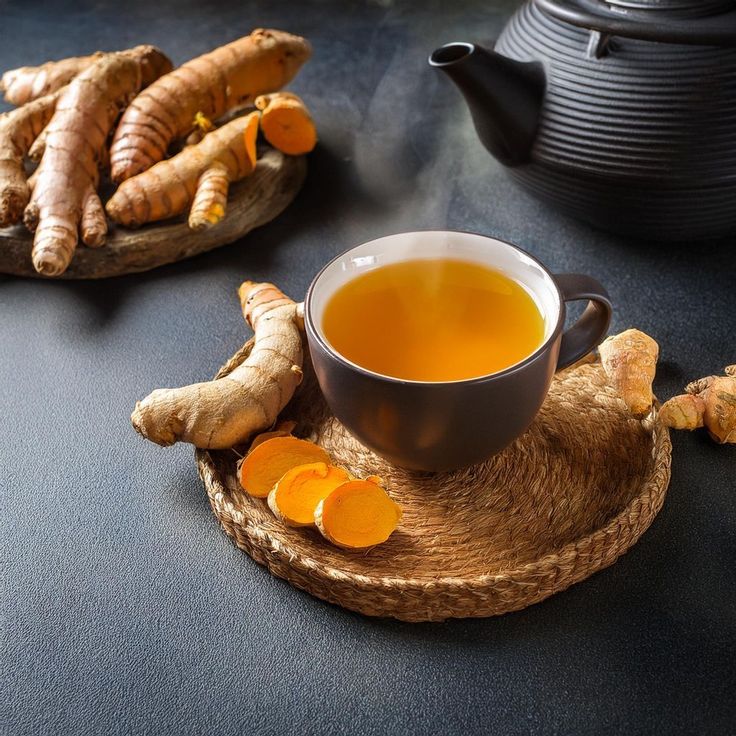
Curcumin is the main component of turmeric that gives it most of its therapeutic properties, this component is anti-oxidant, anti-inflammatory, and lowers the two enzymes in the body that cause inflammation. Studies show the curcumin in tumeric may help prevent or reduce the risk of certain forms of dementia, like Alzheimer’s. Curcumin also has anti-bacterial properties that make tumeric excellent for skin and hair health as well! The culture of India has used tumeric for skin, hair, and overall body health for thousands of years, here’s a recipe for a Morning Tumeric Face Mask!
————————————————————————————————————————————————————————
Conclusion
I believe God created a natural resource of medicine for all of our ailments in nature. Just like He created salvation for our soul, even though we would fail Him everyday and keep making mistakes, He created a way to heal through His son Jesus Christ’s great sacrifice. We are given everything we need to live a physically and spiritually healthy life, all we have to do is look for it.

This article is not intended to shoot down pharmaceutical medicine or to create fear of man-made products, but to spotlight the amazing benefits of natural medicine and give an alternative to healing. Please consult your doctor before using strong herbal medicinals if you have any medical illnesses.
To end this article, I want to quote Genesis 1:11, “And God said, “Let the earth sprout vegetation, plants yielding seed, and fruit trees bearing fruit in which is their seed, each according to its kind, on the earth.” And it was so.”

